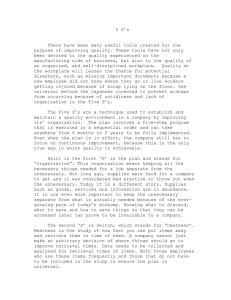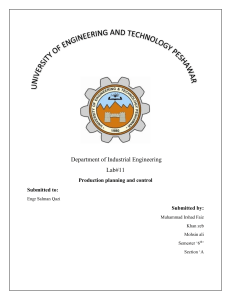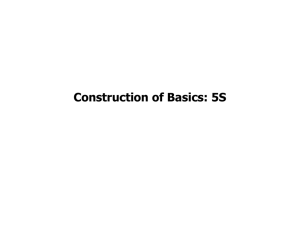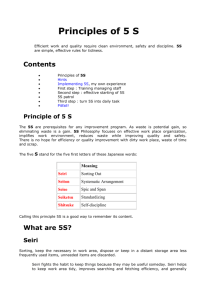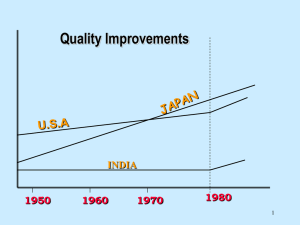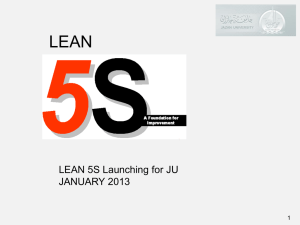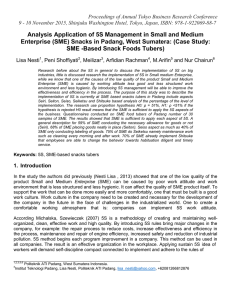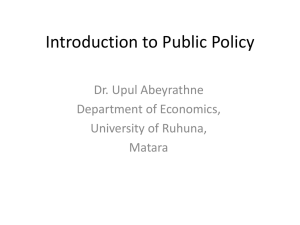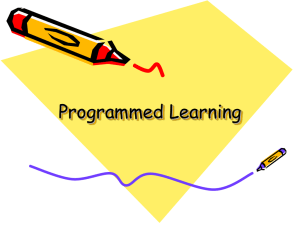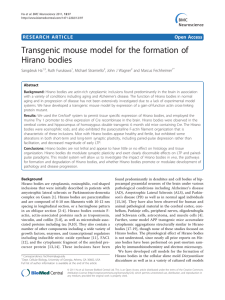5S (methodology) group 7
advertisement
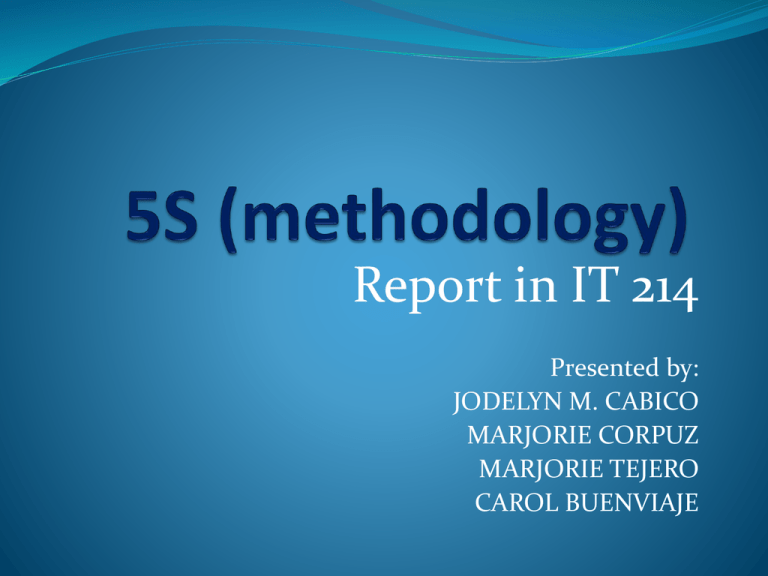
Report in IT 214 Presented by: JODELYN M. CABICO MARJORIE CORPUZ MARJORIE TEJERO CAROL BUENVIAJE 5S (methodology) 5S is the name of a workplace organization methodology that uses a list of five Japanese words which are seiri, seiton, seiso, seiketsu and shitsuke. It describes how items are stored and how the new order is maintained. The decision-making process usually comes from a dialogue about standardization which builds a clear understanding among employees of how work should be done. It also instills ownership of the process in each employee. The 5S Process, or simply "5S", is a structured program to systematically achieve total organization, cleanliness, and standardization in the workplace. A well-organized workplace results in a safer, more efficient, and more productive operation. It boosts the morale of the workers, promoting a sense of pride in their work and ownership of their responsibilities. Phases of 5S There are 5 Primary Phases of 5S: Sorting (Seiri) Straightening or setting in order / stabilize (Seiton) Systematic cleaning (Seiso) Standardizing (Seiketsu) Sustaining the discipline or self-discipline (Shitsuke) Phases of 5S Sorting (Seiri) It eliminates all unnecessary tools, parts, and instructions. Go through all tools, materials, and so forth in the plant and work area. Keep only essential items and eliminate what is not required, prioritizing things as per requirements and keeping them in easily- accessible places. Everything else is stored or discarded. Straightening or setting in order / stabilize (Seiton) There should be a place for everything and everything should be in its place. The place for each item should be clearly labeled or demarcated. Items should be arranged in a manner that promotes efficient work flow, with equipment used most often being the most easily accessible. Workers should not have to bend repetitively to access materials. Each tool, part, supply, or piece of equipment should be kept close to where it will be used – in other words, straightening the flow path. It also is one of the features that distinguishes 5S from "standardized cleanup". This phase can also be referred to as Simplifying. Systematic cleaning (Seiso) Keep the workplace tidy and organized. At the end of each shift, clean the work area and be sure everything is restored to its place. This makes it easy to know what goes where and ensures that everything is where it belongs. A key point is that maintaining cleanliness should be part of the daily work – not an occasional activity initiated when things get too messy. Standardizing (Seiketsu) Work practices standardized. should be consistent and All work stations for a particular job should be identical. All employees doing the same job should be able to work in any station with the same tools that are in the same location in every station. Everyone should know exactly what his or her responsibilities are for adhering to the first 3 S's. Sustaining the discipline or selfdiscipline (Shitsuke) Maintain and review standards. Once the previous 4 S's have been established, they become the new way to operate. Maintain focus on this new way and do not allow a gradual decline back to the old ways. While thinking about the new way, also be thinking about yet better ways. When an issue arises such as a suggested improvement, a new way of working, a new tool or a new output requirement, review the first 4 S's and make changes as appropriate. Three Other Phases of 5S Safety A sixth phase, "Safety", is sometimes added. There is debate over whether including this sixth "S" promotes safety by stating this value explicitly, or if a comprehensive safety program is undermined when it is relegated to a single item in an efficiency-focused business methodology. Security A seventh phase, "Security", can also be added. In order to leverage security as an investment rather than an expense, the seventh "S" identifies and addresses risks to key business categories including fixed assets (PP&E), material, human capital, brand equity, intellectual property, information technology, assets-in-transit and the extended supply chain. Satisfaction An eighth phase, “Satisfaction”, can be included. Employee Satisfaction and engagement in continuous improvement activities ensures the improvements will be sustained and improved upon. The Eighth waste – Non Utilized Intellect, Talent, and Resources can be the most damaging waste of all. The Origins of 5S 5S developed, as with so many of today’s best practice tools, in Japan. We first heard of it as one of the techniques that enabled what we then termed ‘Just in Time Manufacturing’. The Massachusetts Institute of Technology’s 5-year study into the future of the automobile in the late 1980s identified that the term was inappropriate since the Japanese success was built upon far more than components arriving only at the time of requirement. John Krafcik, a researcher on the project, ascribed Lean to the collective techniques being used in Japanese automobile manufacturing; it reflected the focus on waste in all its forms that was central to the Japanese approach. 5S was developed by Hiroyuki Hirano within his overall approach to production systems. Hirano provided a structure for improvement programmed. He pointed out a series of clearly-identifiable steps, each building upon its predecessor. Western managers, for example, had always recognized the need to decide upon locations for materials and tools and upon the flow of work through a work area; central to this (but perhaps implicit) is the principle that items not essential to the process should be removed – stored elsewhere or eliminated completely. By differentiating between Seiri and Seiton, Hirano made the distinction explicit. He taught his audience that any effort to consider layout and flow before the removal of the unnecessary items was likely to lead to a sub-optimal solution. Equally the Seiso, or cleanliness, phase is a distinct element of the change programmed that can transform a process area. Hirano’s view is that the definition of a cleaning methodology (Seiso) is a discrete activity, not to be confused with the organization of the workplace and this clearly helps to structure any improvement programmed. It has to be recognized, however, that there is inevitably an overlap between Seiton and Seiso. The Objectives of 5S Hirano identified a range of benefits from improved housekeeping, all of which can be regarded as falling within the Lean portfolio – that is, they are all based around the elimination of waste in one form or another. The most obvious benefit from items being organized in such a way is that of improved productivity. Production workers being diverted from production to look for tools, gauges, production paperwork, fasteners, and so on is the most frustrating form of lost time in any plant. A key aspect of Hirano’s organization approach is that the often-needed items are stored in the most accessible location and correct adoption of the standardization approach means that they are returned to the correct location after use. Another element of Hirano’s improved housekeeping is improved plant maintenance – workers ‘owning’ a piece of plant, responsible for keeping it clean and tidy, can take ownership for highlighting potential problems before they have an impact on performance. The next aim is perhaps Quality. The degree of impact of dirt in a manufacturing environment, obviously, varies with the nature of the product and its process but there are few, if any, areas where dirt is welcome. Another goal is improved Health & Safety. Clear pathways between workbenches and storage racks can minimize accidents, as can properly-swept floors. As with Quality, a well-organized, clean and tidy facility lends itself more readily to standard practice. The Evolution of 5S Many Western companies now promote Hirano’s approach with a sixth ‘S’ added for Quality. Not unnaturally, there is some debate over this, with devotees on both sides of the argument. The sixth S serves a fundamental purpose – it reminds everyone of the need for Quality. A key lesson taught by Japanese automobile manufacturers, and one central to the TPS, is that traditional levels of performance must be not only exceeded, but replaced by a completely different perception of the scale of what is acceptable. This improvement in quality levels could, of course, only be achieved with a complete redefinition of processes and culture within Western manufacturing. This includes issues such as ‘Design for Manufacturing’ and the fundamental change from Quality Control to Quality Assurance . The contrasting view, and the one taken by Hirano in establishing this approach, is that each and every ‘S’ is a phase. As noted earlier, a major lesson for Westerners was Hirano’s 5S methodology breaking the programmed down into a series of steps. Adding the sixth ‘S’ might be perceived as recommending a programmed carrying out the sorting out, organizing, cleanliness, procedural and cultural steps and subsequently building in Quality, which of course is not possible. If all the objectives have not been built in throughout each element of the definition of the new way of working then they can not be applied as an additional phase. End of the Report
